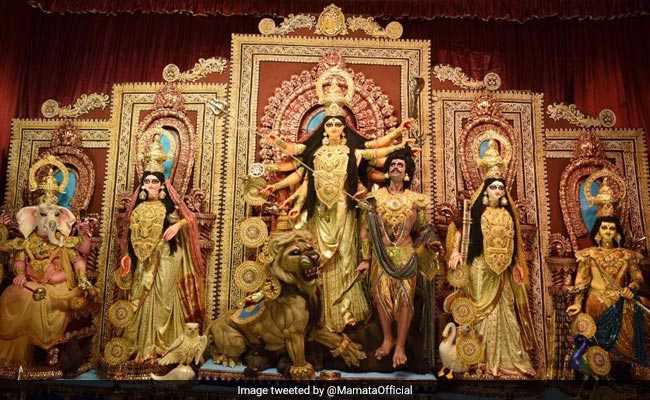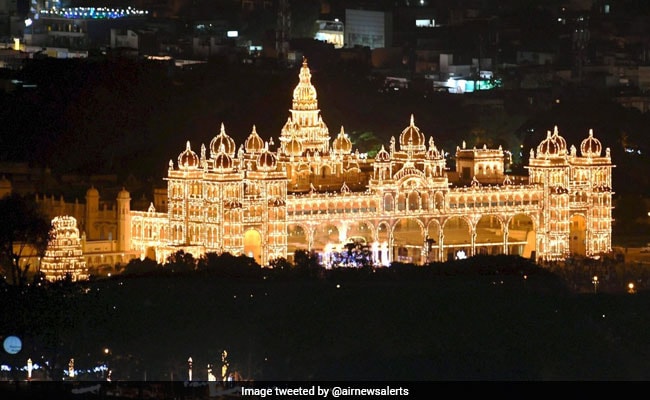
Dussehra, which marks the end of Navratri, is celebrated in many ways in different parts of India
New Delhi:
Dussehra, known as Vijaydashami in some places, is celebrated at the end of Navratri every year, commemorates the victory of good over evil. In some parts of the country, the occasion celebrates Lord Ram's defeat of the demon Ravana, while for some communities it marks Goddess Durga's triumph over the evil Mahishasura.
Dussehra is celebrated vigorously all across the country, with festivities involving lights, decorations, colourful dresses and food. The celebrations vary across different regions of the country.
Dussehra in Delhi
 In Delhi, various grounds host performances of Ramlila, which chronicle the story of Lord Ram and his battle with the evil king of Lanka, Ravana. The performances end with effigies of Ravana, which are stuffed with firecrackers, being burnt to the ground, signifying his defeat. As the firecrackers go off, it provides a spectacle for the thousands of people who gather to watch the festivities. One of the largest Ramlila celebrations is held at the Ramlila Maidan in central Delhi.
In Delhi, various grounds host performances of Ramlila, which chronicle the story of Lord Ram and his battle with the evil king of Lanka, Ravana. The performances end with effigies of Ravana, which are stuffed with firecrackers, being burnt to the ground, signifying his defeat. As the firecrackers go off, it provides a spectacle for the thousands of people who gather to watch the festivities. One of the largest Ramlila celebrations is held at the Ramlila Maidan in central Delhi.
Dussehra in West Bengal
 West Bengal celebrates Vijaydashami, which commemorates the tenth day of the famed Durga Puja festival. The festival celebrates Goddess Durga's defeat of the evil buffalo demon Mahishasura.
West Bengal celebrates Vijaydashami, which commemorates the tenth day of the famed Durga Puja festival. The festival celebrates Goddess Durga's defeat of the evil buffalo demon Mahishasura.
Vijaydashami marks the end of the Puja celebrations. On this day, married women offer sindoor to the Goddess, followed by sweets and betel leaves. This is followed by the women putting Sindoor on each other's cheeks. At night, after one final goodbye, the idols are taken to nearby rivers or the ocean to be immersed.
Dussehra in Mysore
 Mysore witnesses one of the most spectacular Dussehra celebrations in the country. Known as Mysuru Dasara, people celebrate Goddess Chamundeswari, another avatar of Goddess Durga, as the vanquisher of Mahishasura.
Mysore witnesses one of the most spectacular Dussehra celebrations in the country. Known as Mysuru Dasara, people celebrate Goddess Chamundeswari, another avatar of Goddess Durga, as the vanquisher of Mahishasura.
The Mysore palace is beautifully illuminated, with 1,00,000 bulbs lighting up the grand building. A procession travels through the city, with the idol of Goddess Chamundeshwari perched atop and elephant which is adorned in gold and other lavish accessories. The procession moves from the Mysore palace to the Banni Mantapa. The celebrations carry on till late in the evening, with a torch-light parade that is undertaken in the outskirts of the city.
Dussehra in Kullu
Dussehra celebrations in the Kullu valley are imbued with culture, traditions and a legacy rich with history. The Dhalpur maidan is beautifully decorated with flowers and lights.
In the 17th century, local King Jagat Singh installed an idol of Raghunath, an avatar of Lord Ram, on his throne on Dussehra and from then onwards God Raghunath was declared as the ruling deity of the Kullu Valley.
The Dhalpur maidan, which is the major hub for celebrations, is beautifully decorated with flowers and lights.
The celebrations start with an idol of Goddess Hadimba being carried from the temple in Manali to the palace of the royal family in Kullu.
From there, the idol is carried to Dhalpur, along with an idol of Lord Ragunath, where they stay till the end of the festivities along with idols of other Gods and Goddesses.
The maidan sees many cultural performances, fairs and exhibitions. On the last day, the idols are carried on a chariot to the Beas river, where they are immersed.
Dussehra in Gujarat
 In Gujarat, Dussehra is celebrated as Navratra. Devotees fast through the day and perform aartis. In the evening, people clad themselves in their traditional, colourful clothing and take part in Garba and Dandiya, which is Gujarat's famous folk dance.
In Gujarat, Dussehra is celebrated as Navratra. Devotees fast through the day and perform aartis. In the evening, people clad themselves in their traditional, colourful clothing and take part in Garba and Dandiya, which is Gujarat's famous folk dance.
Many people also visit iconic pilgrimages, like the temples of Goddess Ashapura Mata, Ambaji temple, and Chamunda Mata temple.
Dussehra is celebrated vigorously all across the country, with festivities involving lights, decorations, colourful dresses and food. The celebrations vary across different regions of the country.
Here is a look at how some places celebrate the Dussehra or Vijayadashami festival:
Dussehra in Delhi

Photo: Ravana effigies are burnt in Ramlila performances to celebrate the victory of good over evil
Dussehra in West Bengal

Photo: Durga Puja is the most awaited festival in West Bengal
Vijaydashami marks the end of the Puja celebrations. On this day, married women offer sindoor to the Goddess, followed by sweets and betel leaves. This is followed by the women putting Sindoor on each other's cheeks. At night, after one final goodbye, the idols are taken to nearby rivers or the ocean to be immersed.
Dussehra in Mysore

Photo: The Mysore palace, lit up with 1,00,000 bulbs, makes for a dazzling sight
The Mysore palace is beautifully illuminated, with 1,00,000 bulbs lighting up the grand building. A procession travels through the city, with the idol of Goddess Chamundeshwari perched atop and elephant which is adorned in gold and other lavish accessories. The procession moves from the Mysore palace to the Banni Mantapa. The celebrations carry on till late in the evening, with a torch-light parade that is undertaken in the outskirts of the city.
Dussehra in Kullu
Dussehra celebrations in the Kullu valley are imbued with culture, traditions and a legacy rich with history. The Dhalpur maidan is beautifully decorated with flowers and lights.
In the 17th century, local King Jagat Singh installed an idol of Raghunath, an avatar of Lord Ram, on his throne on Dussehra and from then onwards God Raghunath was declared as the ruling deity of the Kullu Valley.
The Dhalpur maidan, which is the major hub for celebrations, is beautifully decorated with flowers and lights.
The celebrations start with an idol of Goddess Hadimba being carried from the temple in Manali to the palace of the royal family in Kullu.
From there, the idol is carried to Dhalpur, along with an idol of Lord Ragunath, where they stay till the end of the festivities along with idols of other Gods and Goddesses.
The maidan sees many cultural performances, fairs and exhibitions. On the last day, the idols are carried on a chariot to the Beas river, where they are immersed.
Dussehra in Gujarat

Photo: People dress up in colourful clothing and play Garba and Dandiya in Gujarat
Many people also visit iconic pilgrimages, like the temples of Goddess Ashapura Mata, Ambaji temple, and Chamunda Mata temple.
Track Latest News Live on NDTV.com and get news updates from India and around the world

